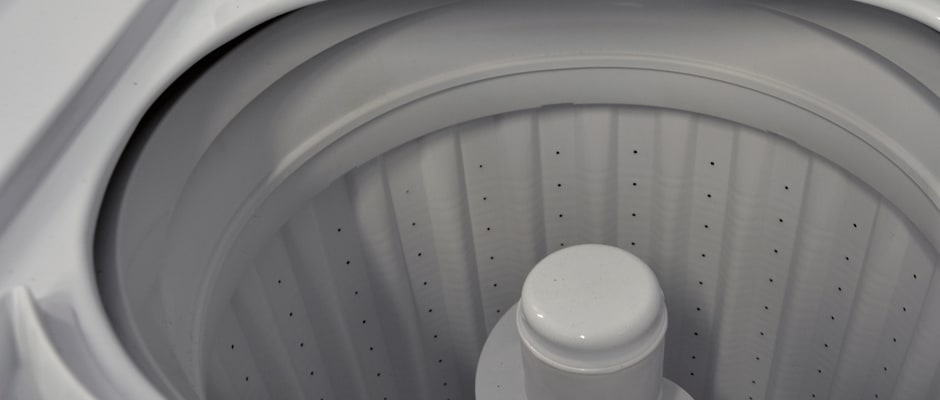Pros
Cons
Introduction
Design & Usability
{{section_header}}{{section.name}}{{/section_header}}
This is your mother's washing machine.
A top-loading washing machine with a pole agitator in the middle, Hotpoint has rehashed a time tested technology. "Four knobs and a door that slams" sounds like the start of a dirty joke. However, it's the control scheme to this washer. This system was simple to use, but it wasn't easy. For example, after setting all the dials to their desired settings, you pull the main knob and the machine rumbles to a start, but it never gives any signal that it's done. Also, the four dials that control the washer are simple and straightforward, but are so simplistic that there seems to be gaps in their coverage, such as a lack of a heavy-duty cycle or the ability to add an extra spin to help dry out your clothing.
{{photo_gallery "Front Image", "Controls 1 Photo", "Controls 2 Photo", "Drawer Photo", "Lint Trap Photo", "Interior Photo", "Interior Detail Photo", "Sides Photo", "Sides Detail 1 Photo", "Side Detail 2 Photo", "Back Photo", "Back Detail Photo"}}
Performance & Features
{{section_header}}{{section.name}}{{/section_header}}
Stains, Pains, and Great Danes
If we had to personify the {{product.name}} removing stains we'd imagine it pummeling them into submission. For the most part, it did very well in dealing with protein-based stains. The only exception was the Whites cycle, which didn't remove blood as much as push it about, leaving behind heavy blotches.
There are three different cycles: Colors, Whites, and Permanent Press. In addition, you can set each of these cycles to either a Light or Heavy setting. You can also set the washer for a Small, Large or Super-Sized load. Temperature wise, there's Cold to Cold, Cold to Warm and Warm to Hot; in real terms these temperatures ranged from 85 to 124 degrees. Finally, you can turn Power Rinse on or off, which is supposed to wash away an excess fabric softener. Doing the math, there are 108 different settings; although that's a lot of settings, it doesn't offer a lot of control. For example, spin speed and water usage will be beyond your ability to effect.
All these cycles were inefficient. They used a lot of water. Typical to their design, top loaders use more water than their front loading counterparts, since they “float” laundry to move it around the drum. The Hotpoint HTWP1200DWW’s usage ran from 24.67 gallons on the Heavy cycle to 31.5 gallons on Permanent Press. This all adds up. Using national average costs, we estimate the yearly running cost of the {{product.name}} in excess of $73 a year.
In conclusion, we know someone who owns a Great Dane.
Conclusion
{{section_header}}{{section.name}}{{/section_header}}
Top-loaders are reaching the end of their era.
The {{product.name}} is a fine example of what a traditional top-loader can do. However, looking at the test results this washer can't stand up to the steady march of progress. Although it had a fairly strong cleaning performance, it tore through clothing like rabid animal. Furthermore, this top-loader uses a lot of water, double or more the average front-loader. Yet there's more to an appliance than just how well it works. The price of this machine can't be ignored. It has an MSRP of $479, and with a bit of shopping we found models going for as low as $450.
Science Introduction
{{section_header}}{{section.name}}{{/section_header}}
The {{product.name}} had a strong cleaning performance, but weak everything else. We give it props—a washing machine should clean laundry well. However, we can't ignore how much water it used and how it tore through clothing.
Cleaning Peformance
{{section_header}}{{section.name}}{{/section_header}}
The {{product.name}} took no prisoners when it came to stains.
In order to determine cleaning performance, we use sets of stains strips which have standardized patches. Each patch is stained with common household dirtying agents. They include things like sebum (sweat), blood, oil, red wine, and cocoa. These strips are placed in eight pound loads of laundry with a pre-measured amount of industry approved detergent. When the cycle is complete, these strips are scanned by a light spectrometer. These readings are compared to control samples to determine how much of the stain has been removed.
The {{product.name}} performed beyond our expectations. This machine pummeled clothing, knocking the stains right out of them. On its hottest settings, this washer reached temperatures of over 124ºF which will allow it work well with bleach to keep your whites their whitest.
{{photo_gallery "Science Section 1 Images"}}
Efficiency
{{section_header}}{{section.name}}{{/section_header}}
Drawing inspiration from previous generations, the {{product.name}} is just as efficient.
The basic physics of a top-loader require it to use a lot of water. The interior drum has to fill, floating laundry. The Hotpoint HTWP1200DWW’s usage ran from 24.67 gallons on the Heavy cycle to 31.5 gallons on Permanent Press. This machine also lacks a detergent dispenser. It's easy to just dump it on top, but not mixing with water first creates an uneven coating on your laundry. All this extra water comes at a cost. Based on national averages, we estimate that the yearly operating cost to be in the neighborhood of $73.
{{photo_gallery "Science Section 2 Images"}}
Clothing Wear
{{section_header}}{{section.name}}{{/section_header}}
Things fall apart like cookies too long in milk
Something to keep in mind about when dealing with top-loading washing machines is clothing wear and tear. Machines with pole agitators are, by their nature, more prone to damaging clothing. In this case, the {{product.name}} is no exception. To ensure objectivity, we place in mechanical action strips to quantify clothes wear. Mechanical action strips are standardized pieces of cloth that have five one-inch holes in them. After a cycle, we count how many threads are hanging more than one centimeter away from the edge of the holes. On average, the {{product.model}} loosened around 76 threads, which is more than the ideal.
{{photo_gallery "Science Section 3 Images"}}
Other Tests
{{section_header}}{{section.name}}{{/section_header}}
{{photo_gallery "Other Tests Images"}}
Meet the tester
Jonathan Chan currently serves as the Lab Manager at Reviewed. If you clean with it, it's likely that Jon oversees its testing. Since joining the Reviewed in 2012, Jon has helped launch the company's efforts in reviewing laptops, vacuums, and outdoor gear. He thinks he's a pretty big deal. In the pursuit of data, he's plunged his hands into freezing cold water, consented to be literally dragged through the mud, and watched paint dry. Jon demands you have a nice day.
Checking our work.
Our team is here to help you buy the best stuff and love what you own. Our writers, editors, and experts obsess over the products we cover to make sure you're confident and satisfied. Have a different opinion about something we recommend? Email us and we'll compare notes.
Shoot us an email

